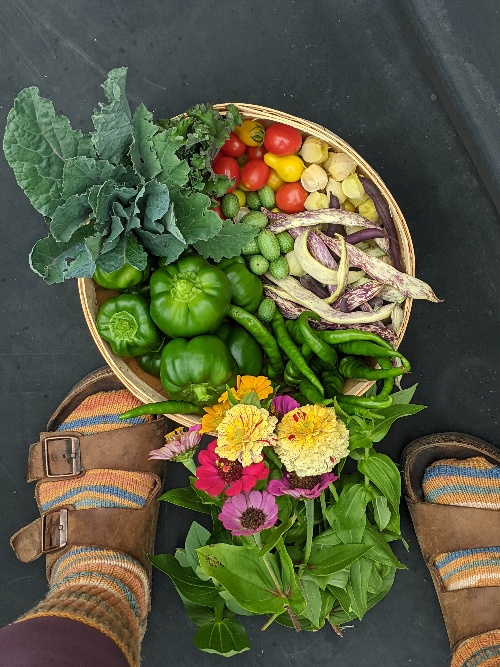
Blueberries are a favorite fruit to grow among home gardeners because they’re delicious, don’t take up a ton of room, and are pretty easy to grow as far as fruit goes. But they’re also a beautiful landscape plant. They have glorious red leaves in the fall, dainty cream-colored flowers in the spring and shiny emerald green leaves and deep blue fruits in the summer.
It stands to reason, then, that the only thing better than blueberries is more blueberries.
And if you want more blueberries, now is the time to act. Late winter into early spring is the ideal time to propagate blueberries from existing plants via hardwood cuttings.
If you’ve never done it before, the process can seem a little intimidating. But by the time you’re done reading, you’ll see there’s nothing to it and your significant other will probably be saying, “Yes, I know it’s easy, honey, but where are we going to plant all these new blueberry bushes?”
Why Propagate Blueberries from Cuttings?
Yup, I know. You’re probably thinking to yourself,
“Why bother going out in this frigid weather to take cuttings when I can buy new bushes in a month or so at the garden center?”
Yes, you could do that, but there are a few benefits to growing blueberries from cuttings.
The first and most obvious is that…
They’re Free!
Blueberry bushes can be pretty spendy, especially if you want more than one or two. If you’re looking to harvest buckets of blueberries every year and you’re already growing varieties that you love, it makes sense to propagate more from your existing stock.
Even better, it’s a great way to help friends and family who would like to grow blueberries, too.

More blueberries. Free plants. It’s a win-win.
You Get an Exact Clone
When you take cuttings, you get an exact clone of the parent plant. That means genetic consistency; everything that made you choose that variety in the first place – fruit size, flavor, disease resistance – is all there in that cutting.
Your Cuttings Are Local
Because you’re taking an existing part of your plant, it’s already adapted to the microclimate that the parent plant is growing in. The soil, the nutrients, the pH, the weather for your area, these are all things your cutting doesn’t have to adapt to the same way a new nursery plant would. This leads to more successful transplants.
Self-Sufficiency and Sustainability
If these are concepts that are important to you, then buying new plants from a commercial nursery might not fit in with your values. Growing new plants from existing plants is a more sustainable way of gardening, especially in the long term.
Softwood vs. Hardwood Cuttings

You can take either softwood or hardwood cuttings to grow new blueberry plants. Both have their advantages.
Softwood cuttings are those that are taken from new (soft) growth in late spring to early summer. These are often more delicate cuttings with a lower success rate, but they root faster, within 4-6 weeks. You also have to keep a closer eye on them as they tend to dry out without proper care.
Hardwood Cuttings, which are what we’re doing now, are taken from more mature wood in late winter while the plant is dormant. Naturally, these cuttings take longer to root. It can take anywhere from two to four months. However, they need less babysitting and tend to produce sturdier new plants.
There’s nothing wrong with propagating from either soft or hardwood cuttings. You can have success with both. Consider trying out both and see which you have the best luck with. But in this article, we’ll be focusing on hardwood cuttings.
Materials You’ll Need
To give your cutting the best possible chance of success, you’ll need the following:
- – Healthy, disease-free blueberry bush to take cuttings from
- – Sharp, sterilized pruning shears (see how to sharpen your shears for a clean cut here)
- – Rooting hormone (powder or gel)
- – Seed-starting mix (make your own)
- – Nursery tree pots (use any tall, slender container, but these are great, and you can use them for tomato seedlings, too.)
- – Plastic wrap, elastic bowl cover or plastic bag (to keep in the humidity)
- – Spray bottle for misting
- – Heat mat (again, optional, but helps with root development, and they’re inexpensive)
- – Something to label your cuttings with
How to Propagate a Blueberry Bush from a Hardwood Cutting

Selecting the Stem
Basically, hardwood cuttings are the previous year’s softwood. So, you’re looking for a healthy whip or stem that’s a year old. Choose stems that are anywhere from a foot to three feet long. You want the stems to have plenty of leaf nodes.
Taking Your Cutting

Carefully cut the stem from the blueberry bush. Then, cut it down into 6”-8” sections, ensuring that each section has three or four leaf nodes on it. If the terminal (the very tip) of the shoot has flower buds, pinch them off.

Using your clean shears, lightly scratch the bottom inch of the stem to expose the cambium, then dip the exposed base in rooting hormone.
Rooting Your Cuttings
Push each stem cutting about halfway to two-thirds of the way into the moistened seed starting mix. You want a couple of the nodes along the stem to be buried. Mist the top of the soil well, then cover the cutting with plastic to create a greenhouse-like environment.

Place your cutting where it will receive bright, indirect light. If the room is cool, you may want to use a heat mat. (Between 70-75F is ideal.)
Post-Cutting Care
Once you’ve got your cutting set up, it’s a game of wait-and-see. Check your cutting often to be sure the soil is staying moist but not waterlogged. Look for signs of mold. If the soil appears to be too damp and cool, leave a little bit of the plastic covering open to encourage better airflow.
Alternatively, you don’t want the seed-starting mix to dry out. It needs to remain damp to encourage rooting. You’re aiming for a balance of high humidity without growing “things” other than the cutting.

Below and Then Above
It’s best not to disturb the cutting while watering and checking on it for a while. After about eight weeks, you can gently pull on the cutting to test whether it’s rooted. If it’s got some grab to it and doesn’t slide out of the seed starting mix easily, it is putting down roots.
If there aren’t any roots, and it’s not rotting or dried out, push it back in the soil, cover it, and keep being patient. Check it again in another month.
Remember, the cutting will grow below the soil, establishing a root system before you notice anything happening above the soil.
Once the cutting has been rooted sufficiently, it will start to produce new growth. When you notice new growth, you can slowly start acclimating the rooted plant to a dryer environment by opening the plastic wrap covering the plant slowly over a period of a few days.
After the new blueberry cutting is acclimated, remove the plastic and continue to water it normally, not letting the soil dry out. You can also begin feeding the plant with a balanced fertilizer.
Transplanting or Potting Up
Eventually, you’ll want to move your plant outside. Whether you’re going to plant it or repot it into a larger container, it will need to be hardened off, just like you do for vegetable seedlings.
Slowly, for a week to ten days, start bringing the young plant outdoors. Keep it in an area that’s sheltered from wind and excessive sun. Keep it outside for longer periods. This will prevent transplant shock and strengthen the plant, meaning it will adapt faster when it’s planted in the ground.
Common Mistakes to Avoid

- Not sterilizing your tools – I know I say this in every article about taking cuttings or pruning, but I can’t stress how important it is. All it takes is losing one plant to disease from dirty shears to learn this lesson the hard way. You certainly don’t want it to be your established blueberry bushes.
- Skipping the rooting hormone – You might be tempted to skip the rooting hormone. Yes, you can root cuttings without it, but you greatly increase your chances of success with it. Set yourself up for success and pick up some rooting hormone.)
- Overwatering – Getting heavy-handed with the mister can lead to fungal issues and rotten stems.
- Letting cuttings dry out – On the other side of that coin, it’s not uncommon to forget about your cuttings and have them dry out. Check them frequently, and you’ll be fine.
- Too Heavy Planting Mix – To start cuttings, whether they be soft or hardwood, you need a very light, well-draining starting mix. Don’t use all-purpose potting soil.
A Couple of Final Tips for Successful Blueberry Propagation
Label your cuttings with the variety and the date you started them. Blueberry cuttings all look the same, so it’s easy to get them mixed up. Noting the date will help you calculate how long before you’re likely to have rooted cuttings.
Give both hardwood and softwood propagation a try. You might find one is easier than the other, or some varieties do better with different cutting types. Gardening is experimenting!
Don’t forget, when it’s time to plant your new bushes, blueberries do best in highly acidic soil. Test the soil before you plant your new bushes.
Finally, be patient. Rooting from hardwoods takes a while. But as the old saying goes, “Good things come to those who wait.”
Here are some great guides to growing blueberries.
The Complete Guide to Planting Blueberry Bushes + Instantly Acidify Your Soil
How & When to Prune Blueberry Bushes for Bountiful Berries Every Year
How & When To Fertilize Blueberry Bushes For Buckets Of Berries
9 Tips for Growing Buckets of Blueberries Year After Year
Yes, propagating blueberries from cuttings requires more work and patience than going to the local garden center. But in the end, it’s worth it. There’s something about growing new plants from one you already have that’s incredibly fulfilling. Not to mention easy on the wallet. If you’re hoping for more blueberries, you’re well on your way.

Get the famous Rural Sprout newsletter delivered to your inbox.
Including Sunday musings from our editor, Tracey, as well as “What’s Up Wednesday” our roundup of what’s in season and new article updates and alerts.


